1846 OC-1
Repunched 1
| Die Pair | 1 - A |
| Date Grid | L QTR / 4-5.5 / Level |
| Obverse Die States | a, b, c, d, e |
|
| Estimated Rarity | R1 |
| 1, 6 Vertical | SH, SH |
| Reverse Die States | a, b, c, d, e, f, g |
|
Comments:
This is the first of two uses of Obverse 1 and the only use of Reverse A.
|
Obverse 1
The following photo shows the Obverse 1 attribution grid. In early states the obverse die exhibits polish lines
slanting up to the left from the denticles below the date, indicated by the lower arrows. The die was polished
midway in the OC-1 mintage, removing these lines. A die line is visible in shield recess #4, also indicated by
an arrow.
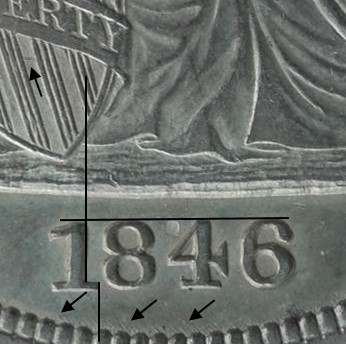

1846 Obverse 1 attribution grid
The 1 is repunched at its top. The original punch shows above the final 1, seen in the next expanded photo.
The repunching weakens in later die states.
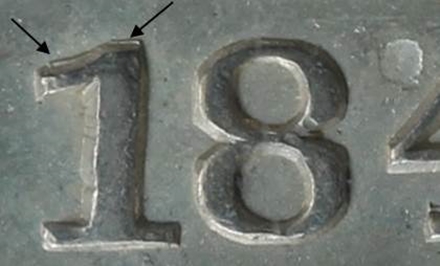

1846 Obverse 1 repunched 1
Obverse 1 exhibits two very prominent lumps on Miss Liberty's left breast. These lumps are shown in the following photo.
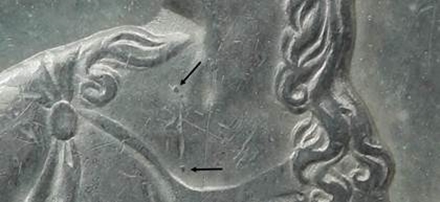

1846 Obverse 1 die lumps on chest
The center lump, just above the V in the gown neckline, is visible on coins as low as VG, and is thus the best marker
to quickly confirm Obverse 1.
Obverse 1 Die States
- Perfect die. Notable die lines extend from the denticles into the field under the date,
slanting up to the left.
- A single very light clash mark is visible in the field under the right arm.
- A faint die crack joins the outer points of stars 9-11.
- An additional die crack joins the inner points of stars 10-12. Another joins the right base of the rock
to the rim, slanting up to the right.
- Die polishing has virtually removed the clash mark and the die lines under the date, as well as the evidence
of the die cracks.
- A new very light clash mark is visible in the field under the right arm.
- Die polishing has virtually removed the clash mark.
- A die crack now crosses the bottom of the date, extending to the denticles on the right and into the field
on the left.
No later die states have been observed. The OC-1 die marriage can be found with obverse die states a through e,
the OC-2 marriage with states e through h.
|
Reverse A
1846 Reverse A features one minor but notable die marker in its early states. A small lump is visible
between the upper berry and the eagle's leg. The photo below shows this lump.
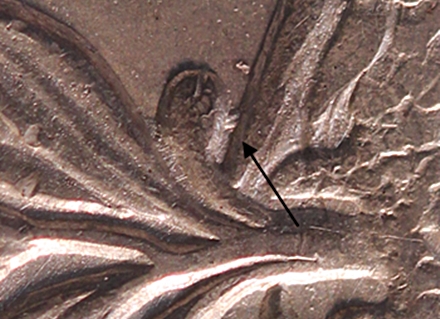

1846 Reverse A lump between berry and leg
The lump is important in early states since it's the only significant difference between reverses A and B that
can be seen under low-power magnification. In later states the dies crack, and the cracks make for easy attribution.
The next photo shows the mid-state die crack for Reverse A.
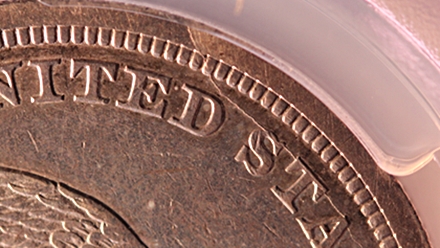

1846 Reverse A die crack
The cracks appear first as a faint crack across the top of STATES, then expand to the state seen in the photo and finally
become even stronger. One low-grade coin has been pictured with what appears to be a retained cud above D ST, but a high-grade
example has not been seen to confirm that state.
Reverse A Die States
- Perfect die.
- A faint die crack crosses the top of STATES.
- Additional reverse die cracks. A very faint crack from the rim below U across the top of UNITED.
The crack across the top of STATES now begins on the rim above D1 and extends across the top of
STATES OF to the rim above A2. A third crack across the top of AMERICA to the rim below A3.
A fourth from the upper arrow tip to the denticles below A3, crossing the previous crack.
- Heavier die cracks. The crack from the rim above D1 is clearly visible crossing the rim.
- The die above D1 show two distinct levels, nearing a retained cud status.
- The two distinct levels now stretch across ST.
- The die crack pictured to the left has created a retained cud above D ST. This die state is
very rare. We’ve seen only a low-grade example. We’d like to confirm it with a higher grade.
The OC-1 die marriage can be found with all the above die states (though as noted state g is not confirmed).
|
Photo credits:
Obverse 1 and Reverse A early die state: 1846 NGC AU58, from the Osburn-Cushing reference collection.
Reverse A
die cracks: 1846 PCGS AU50, from the Osburn-Cushing reference collection.
|
|





